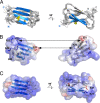Interconversion between two unrelated protein folds in the lymphotactin native state
- PMID: 18364395
- PMCID: PMC2278211
- DOI: 10.1073/pnas.0709518105
Interconversion between two unrelated protein folds in the lymphotactin native state
Abstract
Proteins often have multiple functional states, which might not always be accommodated by a single fold. Lymphotactin (Ltn) adopts two distinct structures in equilibrium, one corresponding to the canonical chemokine fold consisting of a monomeric three-stranded beta-sheet and carboxyl-terminal helix. The second Ltn structure solved by NMR reveals a dimeric all-beta-sheet arrangement with no similarity to other known proteins. In physiological solution conditions, both structures are significantly populated and interconvert rapidly. Interconversion replaces long-range interactions that stabilize the chemokine fold with an entirely new set of tertiary and quaternary contacts. The chemokine-like Ltn conformation is a functional XCR1 agonist, but fails to bind heparin. In contrast, the alternative structure binds glycosaminoglycans with high affinity but fails to activate XCR1. Because each structural species displays only one of the two functional properties essential for activity in vivo, the conformational equilibrium is likely to be essential for the biological activity of lymphotactin. These results demonstrate that the functional repertoire and regulation of a single naturally occurring amino acid sequence can be expanded by access to a set of highly dissimilar native-state structures.
Conflict of interest statement
The authors declare no conflict of interest.
Figures




Similar articles
-
An engineered second disulfide bond restricts lymphotactin/XCL1 to a chemokine-like conformation with XCR1 agonist activity.Biochemistry. 2007 Mar 13;46(10):2564-73. doi: 10.1021/bi602365d. Epub 2007 Feb 16. Biochemistry. 2007. PMID: 17302442 Free PMC article.
-
Lymphotactin: how a protein can adopt two folds.J Chem Phys. 2009 Dec 28;131(24):245105. doi: 10.1063/1.3276284. J Chem Phys. 2009. PMID: 20059117
-
Engineering Metamorphic Chemokine Lymphotactin/XCL1 into the GAG-Binding, HIV-Inhibitory Dimer Conformation.ACS Chem Biol. 2015 Nov 20;10(11):2580-8. doi: 10.1021/acschembio.5b00542. Epub 2015 Sep 2. ACS Chem Biol. 2015. PMID: 26302421 Free PMC article.
-
Lymphotactin.Clin Immunol Immunopathol. 1998 Jun;87(3):218-22. doi: 10.1006/clin.1998.4546. Clin Immunol Immunopathol. 1998. PMID: 9646830 Review. No abstract available.
-
Exploring the structural acrobatics of fold-switching proteins using simplified structure-based models.Biophys Rev. 2023 Jul 14;15(4):787-799. doi: 10.1007/s12551-023-01087-0. eCollection 2023 Aug. Biophys Rev. 2023. PMID: 37681096 Free PMC article. Review.
Cited by
-
Lessons from making the Structural Classification of Proteins (SCOP) and their implications for protein structure modelling.Biochem Soc Trans. 2016 Jun 15;44(3):937-43. doi: 10.1042/BST20160053. Biochem Soc Trans. 2016. PMID: 27284063 Free PMC article. Review.
-
Probing residue-specific interactions in the stabilization of proteins using high-resolution NMR: a study of disulfide bond compensation.J Pharm Sci. 2010 Jun;99(6):2643-54. doi: 10.1002/jps.22055. J Pharm Sci. 2010. PMID: 20187138 Free PMC article.
-
Multistep mutational transformation of a protein fold through structural intermediates.Protein Sci. 2018 Oct;27(10):1767-1779. doi: 10.1002/pro.3488. Epub 2018 Oct 16. Protein Sci. 2018. PMID: 30051937 Free PMC article.
-
Fast protein folding kinetics.Q Rev Biophys. 2014 May;47(2):95-142. doi: 10.1017/S003358351400002X. Epub 2014 Mar 18. Q Rev Biophys. 2014. PMID: 24641816 Free PMC article. Review.
-
Is protein classification necessary? Toward alternative approaches to function annotation.Curr Opin Struct Biol. 2009 Jun;19(3):363-8. doi: 10.1016/j.sbi.2009.02.001. Epub 2009 Mar 5. Curr Opin Struct Biol. 2009. PMID: 19269161 Free PMC article. Review.
References
-
- Anfinsen CB. Principles that govern the folding of protein chains. Science. 1973;181:223–230. - PubMed
-
- Chothia C. Proteins: One thousand families for the molecular biologist. Nature. 1992;357:543–544. - PubMed
-
- Cordes MH, Burton RE, Walsh NP, McKnight CJ, Sauer RT. An evolutionary bridge to a new protein fold. Nat Struct Biol. 2000;7:1129–1132. - PubMed
-
- Luo X, et al. The Mad2 spindle checkpoint protein has two distinct natively folded states. Nat Struct Mol Biol. 2004;11:338–345. - PubMed
Publication types
MeSH terms
Substances
Associated data
- Actions
Grants and funding
LinkOut - more resources
Full Text Sources
Other Literature Sources
Molecular Biology Databases

